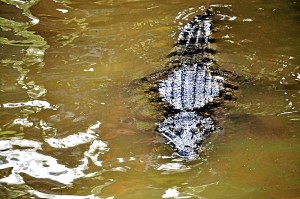PH freshwater crocs to be released in Siargao marsh to propagate species

INQUIRER VISAYAS FILE PHOTO
MANILA, Philippines—Thirty-six Philippine freshwater crocodiles will be introduced to the wilds of Siargao Island in the hope of raising the population of a critically endangered species found only in the country, environment officials said Tuesday.
The yearling crocodiles, six of them male, will be released to the Paghowangan Marsh in Barangay (village) Jaboy in the municipality of Pilar in Surigao del Norte on Friday in what the Protected Areas and Wildlife Bureau (PAWB) of the environment department calls a “benign introduction.”
“Based on our assessment, it will balance the ecosystem of the area, considering that Philippine crocodiles have reduced in number for many years already. We hope it will enrich the ecosystem, enrich the waters, and make more species thrive,” PAWB director Mundita Lim said.
The project is jointly spearheaded by the PAWB of the Department of Environment and Natural Resources, the National Museum, and the Crocodylus Porosus Philippines Inc. (CPPI), which operates Pag-asa Farms in Kapalong town in Davao del Norte.
Lim said the juvenile crocodiles were bred in captivity, the offspring of founder stock of Philippine freshwater crocodile, or Crocodylus mindorensis, loaned by the DENR to Pag-asa Farms.
They will be placed in a semi-controlled habitat spanning 120 hectares in the dry season and more than 600 hectares in the wet season, Lim said.
CPPI president Vicente Mercado said there were human settlements on the project site. “But the people there are used to crocodiles in the area, since there are Indo-Pacific crocodiles, particularly in the town of Carmen,” he said.
“The Philippine crocodiles shy away from humans. And the people there are fishermen, so they are very careful around crocodiles,” Mercado said.
Lim said the reptiles would be tagged in order to keep track of their development. They will feed on naturally occurring species of fish and frogs in the river, she said. The habitat is home to five species of fish, 10 frogs, 21 reptiles, 70 birds, and 15 mammals.
Two crocodilian species occur in the Philippines, the Philippine freshwater crocodile, or Crocodylus mindorensis, which is endemic to the country, and the Indo-Pacific crocodile, or Crocodylus porosus, which is widely distributed throughout the tropical areas of Asia and the Pacific regions.
The Philippine crocodile is considered the most endangered species of crocodilian in the world. It is protected under national law, as well as under the Convention on International Trade in Endangered Species of Wild Fauna and Flora.
It is a relatively small species compared to the Indo-Pacific crocodile, with males known to reach at least three meters, and possibly up to four. (“Lolong,” the world’s largest captive crocodile found in Agusan Marsh, which died of pneumonia recently, was an Indo-Pacific crocodile.)
“Officially, there are an estimated 250 adults [of Philippine crocodile] in the wild, but we suspect there are more, because when you make a statement of 250 individuals, you have to account for every one,” Mercado said.
He said both species have been observed in the Liguasan marsh, the country’s largest wetland spanning over 200,000 hectares and straddling North Cotabato and Maguindanao. “But we are unable to conduct research for reasons known to you.” (The Liguasan marsh is considered a stronghold of Muslim rebels.)
But Mercado and Lim said they did not expect much interaction between the Philippine crocodile and its Indo-Pacific cousin since the latter tended to favor the marshy mangrove areas.
Mercado said it might take 10 to 20 years for the population of the first batch of crocs to stabilize.
“In the farm, let’s say out of 1,000 hatchlings, maybe 500-600 will survive. But in the wild, it could be five percent only,” he said.
“By the time their number gets to over 100 or 200, that can take two decades because of many factors, including stress. There are also predators in the wild unlike in an enclosed area,” Mercado said.
The proponents said the project seeks to promote crocodiles as a flagship species of conservation. This means that the protection measures extend to other species and their habitats affected by the presence or absence of the crocs.
Crocodilians are considered “keystone species” in that they maintain the structure of an ecosystem, including nutrient recycling. Their fecal matter serves as fertilizers in rivers and lakes, making their ecosystems productive of fish and other animals.
Lim said the release of the crocodiles could help enhance the nature tourism of Siargao Island, and contribute to the generation of revenue for the local communities.
The project will also involve sustained biodiversity research on Siargao Island and nearby islands, and forge partnerships with students, researchers, environment officers, local community leaders, and park wardens, she added.
Lim said it was the second time the PAWB introduced Philippine crocodiles to the wild. In 2009, the group, in partnership with environmental foundation, released 50 of the reptiles in Isabela, where they are reportedly thriving.














